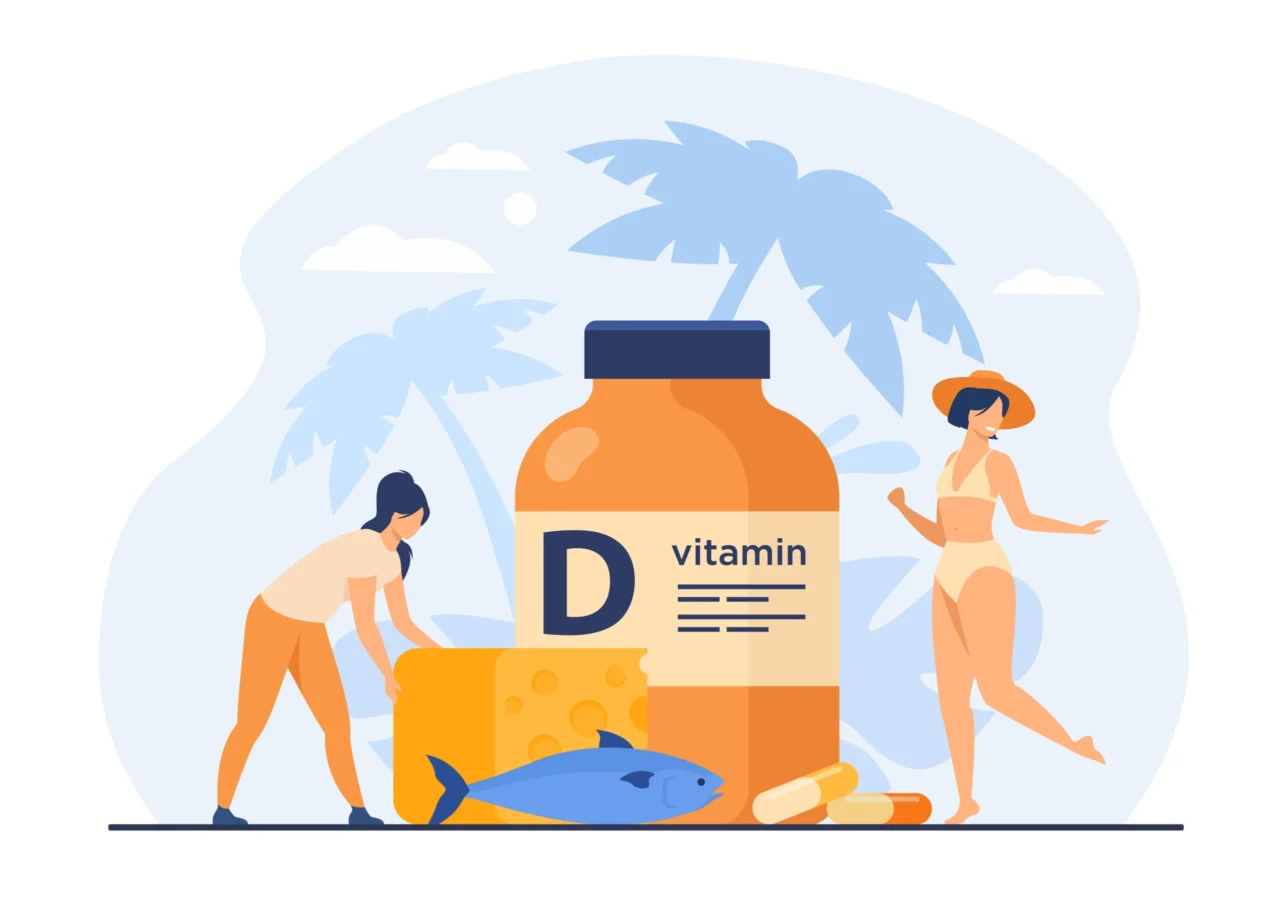Vitamin D Deficiency: Why You Need This Sunshine Vitamin and How to Avoid Problems
Most of us know vitamins keep us healthy. But one vitamin stands out because it’s different from the rest: Vitamin D.
It’s special because your body can actually make it from sunlight. That’s why vitamin D is sometimes called the “sunshine vitamin.” Yet despite this, millions of people around the world don’t get enough vitamin D.
Let’s understand why vitamin D is so important, what happens if you don’t get enough, and how you can keep your body healthy and strong.
What Exactly is Vitamin D, and Why Does Your Body Need It?
Think of vitamin D like a key that unlocks many important jobs in your body. Without it, certain doors stay closed, and your body can’t work as it should.
Here’s why vitamin D is so important:
1. It Helps Your Bones Stay Strong
Vitamin D helps your body absorb calcium, the mineral that keeps bones and teeth hard and strong. Without vitamin D, even if you eat plenty of calcium, your body can’t use it properly.
Over time, bones can become soft, weak, or even bend, especially in children.
2. It Supports Your Muscles
Low vitamin D can make muscles:
- Weak
- Tired
- More likely to ache
People with severe deficiency sometimes find it hard to climb stairs, get up from chairs, or carry heavy objects.
3. It Keeps Your Immune System Working
Your immune system fights off germs like viruses and bacteria. Vitamin D helps keep your immune system strong, so you’re less likely to get sick.
4. It Helps Control Mood and Mental Health
Some studies show vitamin D may play a role in:
- Mood swings
- Depression
- Feeling tired or low in energy
Scientists are still learning more, but there’s definitely a connection between vitamin D and how your brain works.
How Does Your Body Get Vitamin D?
There are three main ways you can get vitamin D:
1. Sunlight
When sunlight (specifically UVB rays) hits your skin, your body makes vitamin D naturally.
Several things can block this process:
- Skin colour: Darker skin has more melanin, which blocks UV rays.
- Age: Older skin makes less vitamin D.
- Geography: People living farther from the equator get less strong sunlight.
- Clothing: Covering your skin blocks sunlight.
- Sunscreen: Sunscreen protects skin but also blocks vitamin D production.
- Season: Winter sunlight is weaker and often doesn’t provide enough UVB rays.
Example:
A person living in Canada or Northern Europe might hardly produce any vitamin D in winter because the sun is too weak.
2. Food
Not many foods naturally contain vitamin D. Some examples include:
- Fatty fish (like salmon, tuna, sardines)
- Cod liver oil
- Beef liver
- Egg yolks
Because most people don’t eat enough of these foods, many products are fortified with vitamin D. Fortified means manufacturers add vitamin D to foods like:
- Milk and soy, or almond milk
- Breakfast cereals
- Orange juice
- Margarine and spreads
Example:
A glass of fortified milk can provide a good amount of vitamin D if you drink it every day.
3. Supplements
Some people can’t get enough vitamin D from sunlight or food, especially if they:
- Stay indoors a lot
- Have darker skin
- Are older
- Have medical conditions affecting absorption
Supplements are an easy way to raise vitamin D levels.
There are two types:
- Vitamin D2 (ergocalciferol): Found in some plants and fungi.
- Vitamin D3 (cholecalciferol): Found in animal products and made in your skin from sunlight. D3 is usually better at raising blood levels.
Always check with a doctor before taking supplements, especially in high doses.
What Causes Vitamin D Deficiency?
Many things can lead to low vitamin D levels. Let’s look at some common reasons:
Not Enough Sunlight
People who:
- Stay indoors most of the time
- Cover their skin for cultural or religious reasons
- Use a lot of sunscreen
- Live in places with long winters
Often don’t make enough vitamin D.
Darker Skin
People with dark skin have more melanin. While melanin protects the skin from sun damage, it also reduces vitamin D production.
Example:
A person with dark skin might need 3-5 times more sunlight to make the same vitamin D as someone with fair skin.
Age
As people age, their skin becomes less able to make vitamin D from sunlight.
Digestive Disorders
Conditions that affect the gut — like Crohn’s disease, celiac disease, or ulcerative colitis — can make it hard for the body to absorb vitamin D from food.
Obesity
Vitamin D is stored in body fat. In people with obesity, more vitamin D gets trapped in fat cells, leaving less available in the blood.
Liver or Kidney Problems
Your liver and kidneys help turn vitamin D into its active form that the body can use. Diseases affecting these organs can lead to low vitamin D levels.
Symptoms of Vitamin D Deficiency
Some people with low vitamin D levels feel fine at first. But over time, symptoms can appear. Here’s what to watch for:
Bone Pain and Weakness
- Dull, aching pain in bones
- Pain in the lower back, hips, or legs
- Bones that feel tender
Example:
A person might feel like their legs ache after standing or walking for a while.
Muscle Weakness
Low vitamin D can cause:
- Trouble getting out of a chair
- Difficulty lifting objects
- Feeling unusually tired
Fatigue
Many people with low vitamin D feel tired all the time, even if they’re sleeping enough.
Mood Changes
Low vitamin D is linked to:
- Feeling sad or depressed
- Mood swings
- Trouble concentrating
Frequent Illnesses
Vitamin D helps your body fight infections. Low levels can make you:
- Get colds or flu more often
- Heal more slowly from wounds
Hair Loss
Some research shows that low vitamin D might be linked to hair thinning, though more studies are needed.
Bone Diseases
- Rickets: In children, bones become soft and bend, causing bow legs.
- Osteomalacia: In adults, bones become soft, leading to pain and a higher risk of fractures.
How Do Doctors Check Vitamin D Levels?
Doctors diagnose vitamin D deficiency with a simple blood test called the:
- 25-hydroxyvitamin D test (25(OH)D test)
Most doctors consider:
- Levels above 20 ng/mL are adequate for bone health.
- Levels below 20 ng/mL are deficient.
They might also check:
- Calcium levels
- Phosphorus levels
- Parathyroid hormone levels
Treatment for Vitamin D Deficiency
Treatment depends on how low your levels are:
- Mild deficiency: Eat more vitamin D-rich foods, spend safe time in sunlight, and possibly take small supplements.
- Severe deficiency: Doctors may prescribe higher doses of vitamin D supplements for several weeks or months.
Too much vitamin D can be harmful, causing:
- High calcium levels
- Kidney problems
- Heart issues
Always follow your doctor’s advice.
How Much Vitamin D Do You Need Daily?
Recommended daily vitamin D intake:
- Infants (0-12 months): 400 IU
- Children (1–18 years): 600 IU
- Adults up to 70 years: 600 IU
- Adults over 70 years: 800 IU
- Pregnant or breastfeeding women: 600 IU
Some people may need higher doses based on health conditions.
Vitamin D-Rich Foods You Can Eat
Try adding these foods to your diet:
- Fatty fish like salmon, mackerel, and sardines
- Cod liver oil
- Egg yolks
- Beef liver
- Fortified milk or soy milk
- Fortified cereals
- Fortified orange juice
FAQs About Vitamin D Deficiency
Q1: Can vitamin D deficiency cause weight gain?
Not directly. But low vitamin D levels are linked to weight problems, though scientists are still studying how they’re connected.
Q2: Can you get too much vitamin D?
Yes. High doses can cause vitamin D toxicity, leading to nausea, vomiting, weakness, and kidney problems.
Q3: Can vitamin D deficiency cause hair loss?
It might play a role in hair thinning, but many other factors can also cause hair loss.
Q4: How quickly can vitamin D levels improve?
With supplements, levels can improve in a few weeks, but it may take months to correct a deficiency fully.
Q5: Who is most at risk for low vitamin D?
People who:
- Have dark skin
- Stay indoors often
- Are older adults
- Have digestive issues
- Are obese
Final Thoughts
Vitamin D is vital for your bones, muscles, immune system, and even your mood. Many people don’t realize they’re low in vitamin D until they start feeling tired, weak, or have bone pain.
The good news: Vitamin D deficiency is often preventable and treatable. A healthy diet, safe sun exposure, and medical guidance can help keep your levels where they should be.
If you’re feeling unusually tired, achy, or down, talk to your doctor. A simple blood test could be the first step to feeling better.



